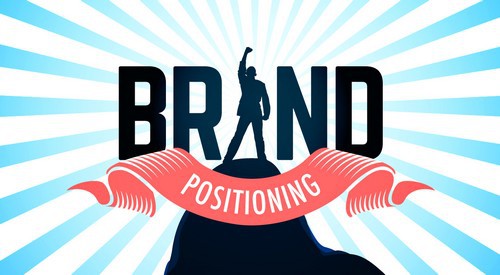Table of Contents
What is Brand Positioning?
Brand Positioning is the positioning strategy of the brand with the goal to create a unique impression in the minds of the customers and at the marketplace. Brand Positioning has to be desirable, specific, clear, and distinctive in nature from the rest of the competitors in the market. It can also increase top of the mind awareness for customers.
Effective brand positioning enables a firm’s brand to be readily distinguishable from competing brands in the marketplace. Distinguishing the brand from other brands can be in terms of associated brand attributes, benefits to users, and/or market segment emphasis, among other factors. Effective brand positioning further emphasizes elements of superiority along one or more distinguishing dimensions which are valued by consumers.
6 Steps to create Brand Positioning Strategy
1. Identify the current standing
If the brand is new to the market, then this first step doesn’t apply to the new entrants to the market but if the brand is already an established player in the market and wishes to resurrect its Brand Positioning and the overall brand architecture, then it is vital for the management of the company and the branding department to carefully understand and identify the current positioning of the brand and have an analysis how is it working in the favour of the brand and its attainment of the overall business aims and objectives.
If the answer is no, then the management of the company needs to figure out the loopholes in the current Brand Positioning and check if there is a need for the repositioning of the brand.
2. Identify the direct competition
The next step in the line of creating the Brand Positioning is identifying the brands in the marketplace that pose a direct threat to the brand. The brand needs to analyze and understand the core value, brand strengths, nature of products and services offered, ethos, and fundamentals of the competitive brands plus spot their unique selling propositions and the factors that make them different and unique in the market and in the minds of the customers.
3. Understand the standing of the competitor brands
The further step involves understanding the positioning of the competitor brands, basically figuring out their vision statement, mission statement, core values, brand fundamentals, and the entire brand architecture. It is very important to intricately study the positioning and brand strategies of the competitor brands in order to come up with the positioning that is unique and distinctive giving a competitive edge in the market.
4. Identify the uniqueness of the company
This step involves the in-depth introspection of the brand within and identify the core values, fundamentals on which the brand is formulated, strengths, value propositions, long-term vision, and the features and attributes that make the brand unique and different from the rest of the brands in the market offering the similar lines of products and services.
5. Develop the unique selling propositions
In continuation to the previous step, the next stage to the Brand Positioning encompasses developing the unique selling propositions depending on the features, objectives, attributes, core values, and strengths of the brand that will give the brand a unique and distinctive Brand identity in the market and in the customer’s minds.
6. Formulate the messaging statements
Next on the line is working on the messaging statements such as mission statement, vision statement, and the tagline or the brand slogan that is attached with the official logo of the brand. All the messaging statements should be clear, crisp, and unique in line with the attributes and inherent nature of the brand.
Importance of Brand Positioning and strategy
1. Market differentiation
The unique and creative Brand Positioning not only clears the clutter from the market but also gives the factor of differentiation to the brand as compared to its direct and indirect competitors. It makes the brand stand out in the market as well as in the customer’s mind with the unique selling proposition and the strong attributes of the brand getting ingrained in their minds working as a recall factor.
2. Justifies the pricing strategy
Yet another benefit of the Brand Positioning is that it helps the management of the company to justify the pricing strategy. If the pricing of the products offered by the brand is high owing to the feature of quality and class, and the Brand Positioning is formulated in such a way that showcases the factors of quality and class, the pricing part gets automatically justified in the minds of the customers. The same is applicable for the products that are reasonable and affordable in nature and the positioning strategy is planned and executed accordingly.
3. Competitive advantage
A strong Brand Positioning that tactfully and strategically highlights the core values, strengths, attributes, and the unique selling propositions of the brand enjoys the facet of competitive advantage that results in accomplishing the objectives of higher sales, increased market share, customer loyalty, attracting the new set of customers, and elevated profits.
4. Makes the brand more creative
There are quite many brands in the market offering the similar lines of products and services to the same target market and audience but it is the Brand Positioning that makes one brand different and unique from the other. And if the brand is able to come up with the innovative and novel positioning strategy and execution, the brand is adorned with the tag of the creative brand.
A good Brand positioning helps customers to resonate with the values and concepts of brand and helps them to associate with it on a deeper level which is beyond buyer and seller relationship. A positive positioning helps the brand to stand out amongst competitors and gain competitive advantage along with the added market share.
What is a Brand Positioning Statement?
If you want to implement a Brand positioning, then you need a tool like a positioning statement which helps you get more clarity on your objectives.
A Brand Positioning Statement is a positioning tool which helps the brand visualize its products in the right target market with the right brand perception.
A brand might have multiple products in the market and it would want to know what is the ideal brand perception to be achieved for each product. For example – a multi product, multi category company like Unilever wants Dove to have a position of beauty and smooth skin in the mind of customers. Whereas it wants its other product Lifebuoy to have a perception of a soap meant for strength and safety from germs.
Thus, Unilever can use a perceptual map and decide on charting the brand positioning statement for each of the brands that it operates in.
To make a brand positioning statement, a company can consider the 3 C’s of Marketing.
- Customers – Be clear on your target market and be relevant to your customers to occupy top of the mind awareness.
- Company – Know thyself before planning your positioning statement. Do not set unrealistic goals for your company which you cannot achieve.
- Competitors – Clearly define who your competitors are for each brand that you are trying to position. Wrong competitor mapping will result in wrong brand positioning for your company.
Here is a Sample Brand Positioning Statement of Nike which also discusses the purpose of Nike and the position they want to occupy in the customers mind.
8 Types of brand positioning strategies
1) Value-based Brand positioning
Value-based positioning has two approaches and both are based are very much dependent on the quality of the product. They use a psychological approach which exploits the belief that more expensive something is, the better it is. This increases the value in the minds of the customer and the product is positioned as expensive and useful and good.
Alternatively, you can also position your brand as providing high quality and high value-priced products or services. It is essential in value positioning that the company should first establish the values of the product in the market for themselves to sell.
An excellent example of a strategy would be Southwest airlines which are offering affordable flights to people along with free check-in luggage. Thereby Southwest airlines establish its value in the minds of the customer.
2) Quality based Brand positioning
Positioning with the help of an important parameter like quality can be a very challenging positioning strategy. Although it can be combined with other strategies and positioned easily. Every business in the market nowadays is trying to establish quality and its commitment to maintain it.
One unique way to distinguish your products amongst the competitors would be to narrow the focus to a particular area of expertise and use that as branding strategy in terms of quality positioning. For example, when it comes to audio everybody knows that Bose audio is the best, they have positioned themselves in that way. There worked only on one parameter significantly rather than working on all parameters simultaneously.
This makes them specialized in one feature thereby ensuring proper focus on the quality of that particular feature. Another example would be BlackBerry mobile phones which used by selective few in the market but seen as one of the best phones when it comes to security.
3) Competitor based positioning
Since the competition has increased companies are taking this strategy to demonstrate the superiority amongst all other available competitors in the market. Right from insurance companies to mobile phones every company establishes its supremacy by comparing their products or services to other companies or direct competitors.
The messages are usually straight, clear and address the competition directly although some may use an indirect reference to their competitors. An example would be, in 2017 iPhone X was launched with the notch in the mobile for the first time in the industry. Samsung mocked Apple by creating an ad in which a person if the notch stands in the line to buy new Apple iPhone while a person who just switched from Apple to Samsung is depicted to be happier. This was an indirect reference to Apple and its new phone while mocking its shortcomings.
In 2018, Google launched Pixel 3 with a premium feature called Night Sight. To promote that feature during the launch event of the phone the company experts compared of pictures clicked by phone then directly and side by side with a picture clicked by Google pixel 3 with night sight. This would be an example of direct competitor-based positioning.
4) Benefit positioning
Working with the benefits of attributes and communicating those benefits to the customer has been an old strategy followed by many brands. The strategy highlights the benefits of the product or service to the customers and ensures that no competitors can copy them since they unique to that particular brand. Sensodyne is an example which uses benefit positioning and today is a premium toothpaste in the market of oral dentistry and oral hygiene. It has positioned itself as an oral medical solution provider which customer can use on a day-to-day basis to get rid of oral problems.
While other kinds of toothpaste focus on whitening and reducing the bad breath Sensodyne has focused on medical aspects of oral hygiene which is a unique benefit in the market and that has helped them to stand out.
5) Problem and solution positioning
Many brands present themselves as a solution provider to the problems of the customers. The ideology behind such positioning is to demonstrate that this particular brand can help you solve your problems instantly and efficiently. Banks, Insurances, and loans have started themselves to a position as a solution provider.
Often advertised as ‘Need a loan? Contact us and we will get the loan Approved within Minutes or Seconds with minimum documentation’ is the claim which is followed by many banks thereby acting as a solution provider to the financial problems of the customer.
6) Price Positioning
As much as quality plays an important role in the product success price is an equally important factor which determines the enormity of success of a particular brand. Why is there are expensive brand positioning themselves as unique and niche, the appeal to a very limited segment of customers who can afford to purchase them? There still remains a major bulk order chunk of customers who are not able to purchase those nice products or services. It is to appeal to these customers that price positioning is done by many Brands. One such example of price positioning is Air Asia, which is the South Asian airline service, whose operations are based in Malaysia.
The airline has successfully positioned itself as an economic service appealing to the middle class and lower middle class and making foreign tours possible for them. While they may compromise on the quality sometimes, the fact still remains that they are seen as the first choice by every first-time flight travelers who cannot afford to travel by a luxury brand like American airlines.
7) Celebrity-driven positioning:
Using celebrities as a spokesperson to endorse a particular category of product or services has been a popular way for a long time. The aim of celebrity-driven positioning is to get the attention of people and increase brand awareness and recognition by associating the product or a brand with the glamorous personality of the particular celebrity. This is often an expensive affair for the companies but they knowingly choose this method of splurging because of the fact of familiarity and popularity of the celebrity.
This association of celebrity with the brand inspires many buyers who follow the celebrity to buy the same brand and make them feel psychologically associated with the celebrity.
8) Leader-based positioning
Very few companies have opted for this route since to declare a market leader you would require your brand to be the best and unique in the market. Many companies start with this positioning but as competition increases, they fall out and the strategy needs to be revamped. The best examples of long-term leadership-based positioning are done by Facebook. In the segment of social media, Facebook is unique in terms of the services it provides and has the greatest number of users associated with it.
Why there are other players like Instagram which is owned by Facebook, Twitter, Snapchat, none of the services overlaps in the category of services provided by Facebook wild Facebook, on the other hand, provides part of services that all of these provisions. With recent acquiring of Instagram and WhatsApp Facebook has become the unrivalled leader in the industry of social media.
Examples of Brand Positioning strategy
Once the Brand Positioning is in place, the tagline or the brand slogan is attached with the logo of the brand too that aptly conveys the attributes and unique selling proposition in a creative and strategic manner.
Here are some brands which are perfect examples of Brand Positioning as they are the brands with the highest TOMA (Top of the mind awareness) in their industry.
Automobile sector
1) BMW
2) Audi
BMW and Audi are the 2 companies which have the top brand positioning in the automobile sector.
Consumer electronics
3) LG
4) Samsung
5) Sony
6) Panasonic
In consumer electronics and white goods, the market is tough. However, these 4 companies are the ones which have the best brand positioning in the customer mindset.
Banking
7) ICICI
8) HDFC
In banking too, the market is tough and has a lot of players. However, when you talk of top class service and features and benefits, you will find that ICICI and HDFC are two companies with top brand positioning mindset.
Food and beverages
9) Coca Cola & Pepsi (Soft drinks)
10) Cadbury (Chocolates)
In Food and beverages, Coca Cola and pepsi are the two strongest players with top positioning for Beverages. For food based products, Cadbury has the top brand position in customers mind.
FMCG
11) HUL
12) P&G
In the FMCG sector, stalwarts and big time players like HUL and P&G have a higher standing than any other. However, many a times, the customer will know the products of these companies rather than the parent company itself.
Pharmaceutical
13) Johnson and Johnson
14) Cipla
With Cipla’s Ipill and Johnson and Johnson nappies, the pharmaceutical sector has these two players with the top positioning.
IT and technology
15) Accenture
16) Infosys
17) TCS
A sector which is predominantly dependent on western countries. IT and technology has three main players with top positioning. However, in the above order, TCS is in contention to take the number 1 spot and Infosys is slowly but surely leaving the top 3 ranking.
Retail
18) Trent
19) Pantaloons
The retail revolution in India has been profound and both Trent (Tata group) and Pantaloons have been the leaders and they have the top positioning in the Retail segment.
Smart Phones
20) Apple
21) Samsung
Conclusion
Brand Position is one of the crucial elements of the entire brand architecture and strategy as it conveys the values, ethos, vision, and the fundamentals of the brand and the overall company.
Marketers concerned with an effective brand position for their firm’s brands should seek to understand carefully the relevant dimensions along which their brands are able to be distinguishable and distinctive as a result of consumer evaluations of brands in the marketplace. Effective brand position is an important aim in a firm’s marketing strategy development and associated marketing mix management.
Thank you for reading out article about brand positioning
Liked this post? Check out the complete series on Branding


